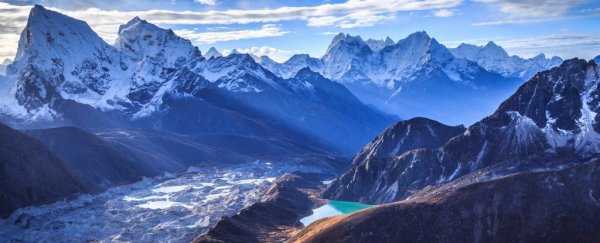
(Feng Wei Photography/Getty Images)
CARLY CASSELLA
30 NOVEMBER 2021
Without an explosion in ocean life more than 2 billion years ago, many of Earth's mountains might never have formed, according to new research.
When tiny organisms in the shallows of the sea, like plankton, die and sink to the bottom, they can add organic carbon to Earth's crust, making it weaker and more pliable.
A case study of 20 mountain ranges around the world, including those in the Rockies, the Andes, Svalbard, central Europe, Indonesia, and Japan, has now linked the timing of high carbon burial in the ocean with the very generation of our planet's peaks.
"The additional carbon allowed easier deformation of the crust, in a manner that built mountain belts, and thereby plate margins characteristic of modern plate tectonics," the researchers write.
The changes seem to have begun roughly 2 billion years ago, in the middle of the Paleoproterozoic Era, when biological carbon from plankton and bacteria began to add exceptionally high concentrations of graphite to the ocean floor's shale. This made the rock brittle and more likely to stack.
Within 100 million years, most mountain ranges began to form in these weakened slices of crust. Mountain ranges that emerged more recently follow the same pattern.
In the Himalayas, for instance, tectonic thrusting around 50 million years ago was focused on Paleoproterozoic sediments with the most organic-rich beds.
The timing and location implies that biological carbon in graphite continues to shape the geology of our planet.
"Ultimately what our research has shown is that the key to the formation of mountains was life, demonstrating that the Earth and its biosphere are intimately linked in ways not previously understood," explains geologist John Parnell from the University of Aberdeen in Scotland.
The data for the study were collected from already published literature on mountain formation and buried marine biomass.
In the past, numerous studies have shown tectonic plates need to be weakened by graphite to create mountains, but how this initially occurs is less clear.
The new research suggests marine life is a key part of the process. All 20 of the mountain ranges studied ultimately held black shale highly concentrated with graphite, which appeared to come from a biological origin.
"We can see the evidence in the northwest of Scotland, where the roots of the ancient mountains and the slippery graphite that helped build them can still be found, in places like Harris, Tiree, and Gairloch," says Parnell.
The surge in marine life 2 billion years ago most likely occurred in response to the Great Oxidation Event, when photosynthesizing bacteria began to produce vast amounts of oxidation, capable of supporting new forms of single-celled life, like an abundance of marine plankton.
Yet the formation of mountains doesn't even require that much biological carbon. Just a small percentage of biomass is needed for the edges of tectonic plates to slip under or over one another when they collide.
In mountain ranges made from Paleoproterozoic sediment, however, carbon content is consistently above 10 percent. Scientists found it sometimes even reaches above 20 percent.
In short, it seems an exceptional surge in marine life billions of years ago set the stage for many of the mountain ranges we see today.
"As the carbon contents of the sediment were anomalously high in the Paleoproterozoic, the flux of carbon into subduction zones was greater, and hence deformation could take place more readily than had been possible hitherto," the authors explain.
If the team is right, it means microscopic single-celled organisms, invisibly floating in the sea, might have played a key role in creating some of the largest geological structures on our planet.
From the littlest things on Earth, the biggest things can grow.
The study was published in Communications Earth & Environment.
No comments:
Post a Comment